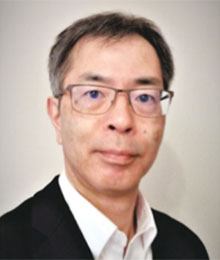Achievement Award
Pioneering research on fiber nonlinearity for telecom applications

Optical fibers, which underpin the modern information infrastructure all over the world, are a silica based optical waveguide through which optical signals receive various effects such as attenuation, dispersion, and third-order nonlinearity. At every stage of technology advancements of optical transceivers such as bit rate increase, technologies that overcome the above-mentioned effects adversely impacting upon optical signals were sought in order to maximize the information capacity carried by an optical fiber. The recipient, Dr. Shu Namiki, has dedicated himself for more than 30 years to not only the creation of original technologies that compensate the attenuation, group velocity dispersion and nonlinearities of fiber, especially by making use of fiber nonlinearities, but also driving them to be commercialized. He produced numerous pioneering research results along with many colleagues and collaborators. Above all, he not only co-invented Raman amplification and four-wave mixing devices capable of broadband operation and wavelength tuning, but also contributed to their commercialization.
After developing the packaging technology of pump lasers that achieved the then highest fiber coupled power at mass production level, and the subsequent three years at Massachusetts Institute of Technology where he studied the dynamic behavior and quantum noise of ultrashort optical pulses in fiber, he proposed and co-invented a novel method of pumping fiber Raman amplifiers, called “wavelength division multiplexed (WDM) pumping,” which enabled a wide and flat gain spectrum over 100 nm [1,2]. Because of the wide-band and low noise characteristics, this method has since been used world-wide as one of the essential technologies for high-capacity and long-distance optical communications, contributing to the evolution of the Internet.
The recipient has also proposed and co-invented a method of generating four-wave mixing exceptionally over a wide band in fiber [3], which significantly contributed to the commercialization and improvement of highly nonlinear fibers. In particular, he showed by suppressing the dispersion slope and optimizing the location of the zero-dispersion wavelength, the wide-band wavelength tunability of the pump without losing the phase matching condition is attained for degenerate four-wave mixing [4], while in conventional cases the pump had to be strictly fixed near the zero-dispersion wavelength. This method enabled simple yet high-quality wavelength tunable four-wave mixing devices, which formed the basis of his various research results as follows. One is the invention of the method that allows the tuning of both dispersion and delay of more than 1-THz ultra-wideband optical signals independently and continuously [5,6]. Conventional methods to control dispersion or delay suffered from the severe trade-off between tunable range and bandwidth, as they had been based on the interference of light waves. This invention relying on a totally different physical mechanism could achieve a figure of merit 10-100 times as large as conventional methods. He has also studied a method to significantly enhance the efficiency of phase sensitive amplifiers [7], and a method to compensate the nonlinear distortions of wavelength division multiplexed signals by all-optical means and demonstrated a nonlinear threshold improvement of 10 dB [8], which was a phenomenal number to overcome the nonlinear Shannon limit, in contrast with conventional means.
In conclusion, the recipient has significantly contributed to pioneering research on optical fiber nonlinearity that had been a subject of science which he has brought to practical applicability. Some of his research outcomes have been commercialized and deployed world-wide. As a result, he has been highly recognized by the international research community, serving not only as an invited speaker at international conferences more than 100 times, but also as a technical program committee member for almost all of the major international conferences in the field of fiber optics. During this course he served as the General Co-Chair for OFC (The Optical Networking and Communication Conference & Exhibition) that is one of the largest and most prestigious conferences in the field. As explained above, Dr. Namiki’s achievements in optical fiber nonlinearity are extremely remarkable and warrant the IEICE Achievement Award.
References
- Raman Amplifiers For Telecommunications 1, M. Islam, ed., Springer- Verlag; S. Namiki, N. Tsukiji, and Y. Emori,“Chapter 5: Pump Laser Diodes and WDM Pumping”, pp. 121-160 (2004).
- S. Namiki and Y. Emori, “Ultrabroad-band Raman amplifiers pumped and gain-equalized by wavelength-division-multiplexed high-power laser diodes,” IEEE J. Sel. Top. Quantum Electron. 7, 1, pp. 3-16, Jan/Feb (2001).
- O. Aso, S. Arai, T. Yagi, Y. Suzuki and S. Namiki, "Broadband four-wave mixing generation in short optical fibers", Electron. Lett., 36, 8, pp. 709-711 (2000).
- S. Namiki, T. Kurosu, K. Tanizawa, S. Petit, Mingyi Gao, J. Kurumida, “Controlling Optical Signals Through Parametric Processes,” IEEE J. Sel. Top. Quantum Electron. 18, 2, pp. 717-725 (2012).
- S. Namiki, “Wide-band and -range tunable dispersion compensation through parametric wavelength conversion and dispersive optical fibers,” J. Lightwave Technol., 26, 1, 28-35 (2008).
- T. Kurosu and S. Namiki, “Continuously tunable 22 ns delay for wideband optical signals using a parametric delay-dispersion tuner”, Optics Letters, 34, 1441 (2009)
- M. Gao, T. Inoue, T. Kurosu, S. Namiki, “Evolution of the gain extinction ratio in dual-pump phase sensitive amplification,” Optics Letters, 37, 9, pp.1439-1441 (2012).
- S. Namiki, K. Solis-Trapala, H. Nguyen Tan, M. Pelusi, T. Inoue, "Multi-channel cascadable parametric signal processing for wavelength conversion and nonlinearity compensation", J. Lightwave Technol., 35, 4, 815-823 (2017).